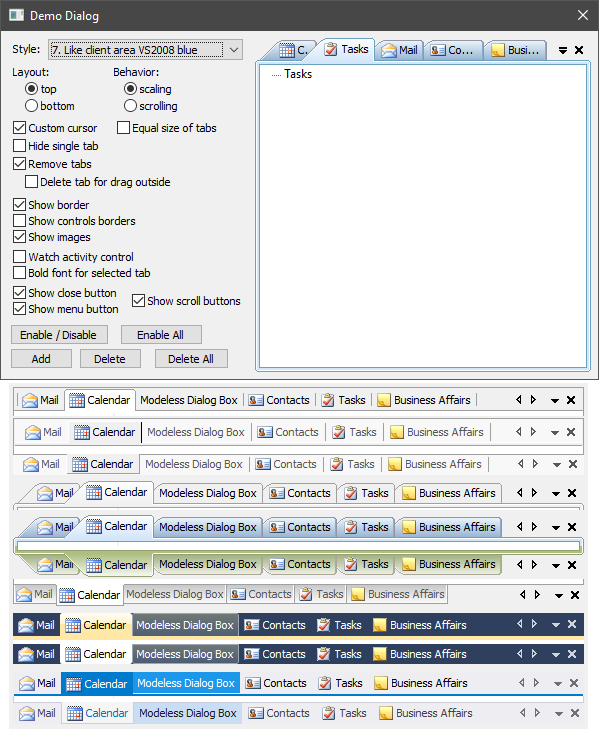
Introduction
Tabs can be top or bottom of child windows. The user can drag tabs using the mouse. Control has a zoom (shrink of tabs) and scrolling tabs mode. Also, if there is one tab, the area of tabs can be hidden.
Control has 28 built-in tab drawing styles, including tabs VS2003, VS2008, VS2010 and VS2019. Drawing for all styles is created programmatically and does not require resources. You can create your own style by editing an existing render class or creating a new one.
This control is based on CWnd class and can be placed as a child window anywhere, for example, in the client area of the frame or dialog.
Using the Code
Child windows are added using their HWND and they can be of any type, for example, modeless dialogs. TabCtrl consists of three areas: control area, tabs area, windows area. This knowledge can be useful to you when creating a drawing class and working with TabCtrl functions.

To create the control and add elements to it, you can do the next steps:
#include "TabCtrl.h"
TabCtrlEx<TabCtrlStyle_VS2019_client_light> m_TabCtrl;
CListCtrl m_List1, m_List2;
...
if( !m_TabCtrl.Create(this,WS_CHILD | WS_VISIBLE,CRect(0,0,0,0),ID_TabCtrl) )
return -1;
if( !m_TabCtrl.CreateSystemImage(NULL,IDB_IMAGES_SYSTEM,true,14) ||
!m_TabCtrl.CreateImage(NULL,IDB_IMAGES_TAB_NORMAL,IDB_IMAGES_TAB_DISABLE,true,16) )
return -1;
if( !m_List1.Create(WS_CLIPCHILDREN | LVS_REPORT,CRect(0,0,0,0),&m_TabCtrl,ID_List1) ||
!m_List2.Create(WS_CLIPCHILDREN | LVS_REPORT,CRect(0,0,0,0),&m_TabCtrl,ID_List2) )
return -1; m_List1.InsertColumn(0,"Mail",LVCFMT_LEFT,100);
m_List2.InsertColumn(0,"Calendar",LVCFMT_LEFT,100);
if( !m_TabCtrl.Add(m_List1,"Mail",0) ||
!m_TabCtrl.Add(m_List2,"Calendar",1) )
return -1;
m_TabCtrl.LoadState(AfxGetApp(),"TabCtrl","State");
m_TabCtrl.Update();
Class TabCtrl does not perform any rendering. For its drawing, it calls the functions of TabCtrl::Draw interface. To draw TabCtrl, you need to create an object inherited from the TabCtrl::Draw class, implement its functions, and pass the TabCtrl::Draw pointer to TabCtrl using the TabCtrl::SetDrawManager function call.
Similarly, a TabCtrl::IRecalc interface is used to specify the size and spacing between TabCtrl areas. A TabCtrl::IBehavior interface will help you adjust the behavior of the TabCtrl, and a TabCtrl::ToolTip will help you create tooltips for tabs and buttons. There is also a TabCtrl::Ability class for setting the ability to click on buttons and a TabCtrl::Notify class for notifying about events in TabCtrl.
If you implement any of the above interfaces, then this implementation must exist for the entire time the control is running. If you are working with only one style, then use the template class, TabCtrlEx. The name of the style class is specified as a template parameter, for example:
TabCtrlEx<TabCtrlStyle_VS2003_client> m_TabCtrl;
Some styles have already been created. For example, styles similar to the docking/floating panels in Visual Studio 2003, 2008, 2010 and 2019. See the TabCtrlComplex class in the DemoDlg.h file for a list of all existing style classes.
Classes ITabCtrlStyle::RecalcStub and ITabCtrlStyle::BehaviorStub create a default implementation for the functions of TabCtrl::IRecalc and TabCtrl::IBehavior interfaces respectively. You can use them to create your own style classes.
The control requires a call of Update() after you add or delete tabs, as well as change its properties and state.
Good luck!
History
- 28th May, 2010: Initial version
- 10th June, 2010: Added redirect
WM_NOTIFY message from child windows to a parent of the TabCtrl control - 12th June, 2010: Corrected error display of tooltips
- 16th March, 2021: Improved sources and text of the article
- 25th March, 2021: Added a new style and scrolling of tabs with the mouse wheel
